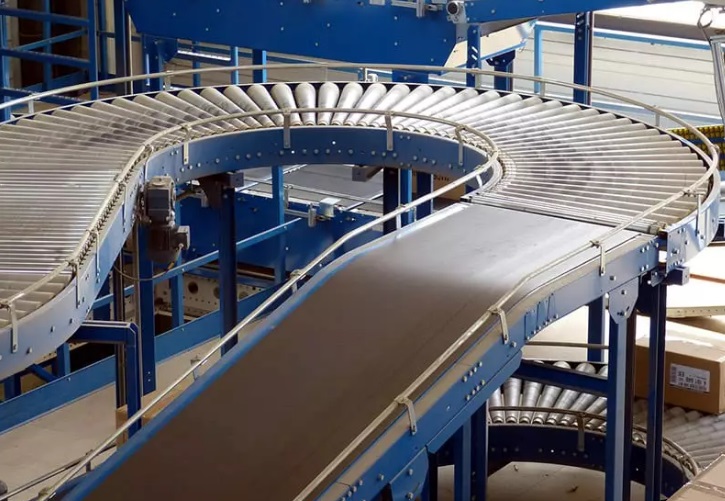
You made great choice of processing equipment, all aspects were critically evaluated and you have pondered on every requirement, but it seems you have either missed or left it on technology partners to take call on conveying systems (material transportation) this might become your bottleneck in future. Hence it’s important to understand the different type of conveyor belts those will carry your material. Below we are try to introduce you with few of such belts:
Roller Bed Conveyor Belts
The surface of this type of conveyor belt is comprised of rollers that are chosen to match production requirements, such as the weight or required speed of the items that will move along the belt. Shorter conveyor belts that fall under this type can be made up of just two rollers. However, as the distance between the two ends of the belt increases, more will be required for the belt to work.
A roller bed arrangement is reasonable for when items are loaded onto the belt with gravity. This is because manual loading can cause mechanical shock and damage the rollers. Roller bed conveyor belts are also a good option for transporting items over long distances as they reduce friction, making it simpler for items to move along the belt.
Flat Belt Conveyors
The flat belt conveyor belt is one of the most pervasive conveyor frameworks being used today. Flat belts are useful for internal transport, for example shipping things inside an office. This kind of conveyor belt utilizes a progression of controlled pulleys to move a persistent flat belt, which can comprise both of common material or manufactured texture (ex. polyester, nylon). Things are set on the moving belt and conveyed from one end to the next.
Since its belts can be made of various types of materials, this kind of conveyor belt is unimaginably adaptable. Discretionary highlights incorporate focus drives and nose bars relying upon the prerequisites of a given application. https://succeedaba.com Flat belt systems are often the conveyor of choice for industrial environments, wash down areas, and slow assembly lines. Fitted with the right belt, it can also convey small, soft, or irregularly shaped items without harming them.
Modular Belt Conveyors
While flat belt conveyors use a single, continuous loop of material, modular conveyor belt systems use a single loop made of countless interlocked pieces, usually made of hard plastic. These portions can be removed and replaced individually, in contrast to having to discard the entire belt. They’re also easier to wash, as well as more resistant to sharp and abrasive materials. This makes modular belt conveyors simpler to maintain and fix than their flat belt counterparts.
Modular belt conveyors are appropriate to applications that include going around corners. Indeed, they can travel straight, circumvent a corner, and slope and decrease utilizing a solitary belt and a similar engine all through. Actually, different kinds of conveyors can likewise achieve this accomplishment, yet just with much customization and extra expenses. Plastic modular belts additionally permit explicit conveyor plans without trading off belt following. A case of this is a belt with more noteworthy width than length, which offers the help required to deal with delicate plastic packs, cardboard boxes, and therapist wrapped goods.
Cleated Belt Conveyors
Cleated belt conveyors highlight vertical spikes or obstructions in their structures. These spikes can keep free materials secure during slopes and decays, to give reliable dividing among things, and that’s only the tip of the iceberg. Moreover, spikes come in various shapes, each with its own application.
Type of Cleated Belts:
- Inverted Capital T
- Forward-Leaning Capital L
- Inverted V
- Lugs and Pegs
Curved Belt Conveyors
This sort of belt conveyor utilizes a curved edge to heft things around corners, make tight exchanges, or augment accessible floor space. These belts’ curves can go up to 180°. Genuine curved conveyors which don’t have any straight runs can just utilize flat belts, as modular plastic belts require straight pursues previously and curves. Curved belt conveyors are frequently utilized in sack taking care of systems to alter things’ passing on course.
Incline/Decline Belt Conveyors
Incline belt conveyors are handy for conveying items up or down. These systems can traverse with cleated belt conveyors to ship items to various heights while shielding them from tumbling off the line. Beside moving items between floors, these conveyor belts are likewise appropriate for boosting gravity stream systems.
Special Type of Conveyor Belts
If you have any special need and above conveyors cannot cater to your requirement, there are several other types of conveyor belts few are listed below:
- Fiberglass belts
- Narrow-width conveyors
- Back-lit belts
- Vacuum belts
- Magnetic belts
- Sandwich belt conveyors
